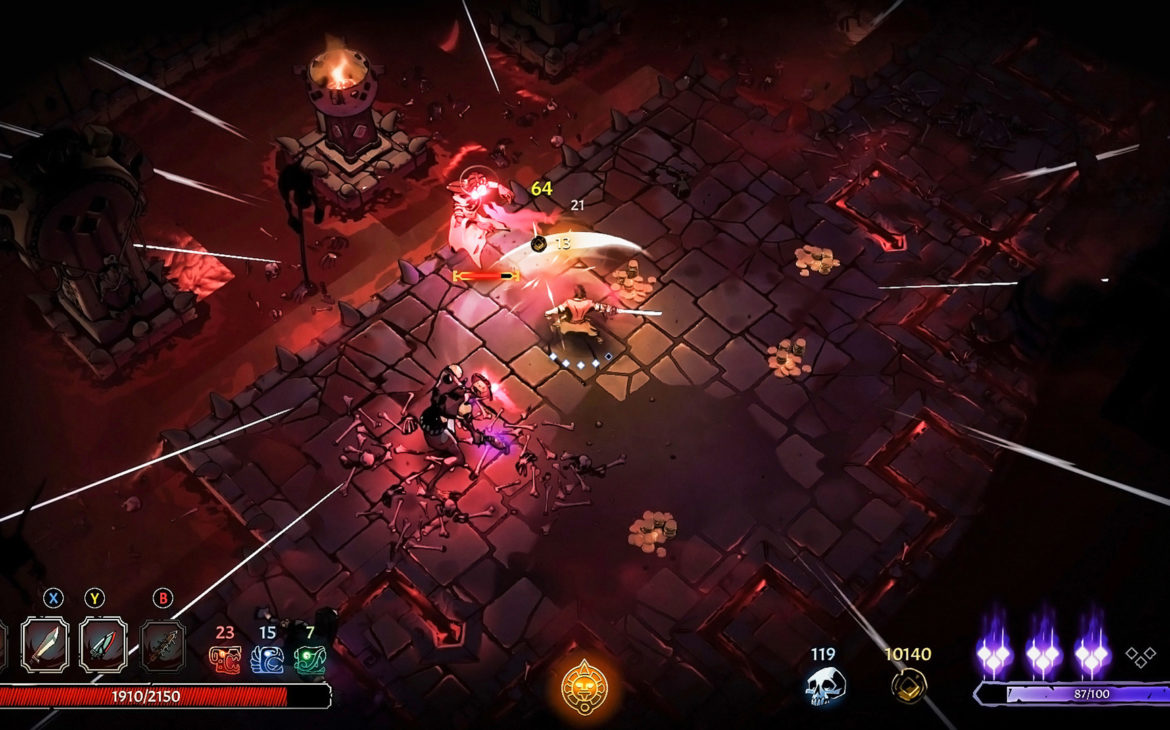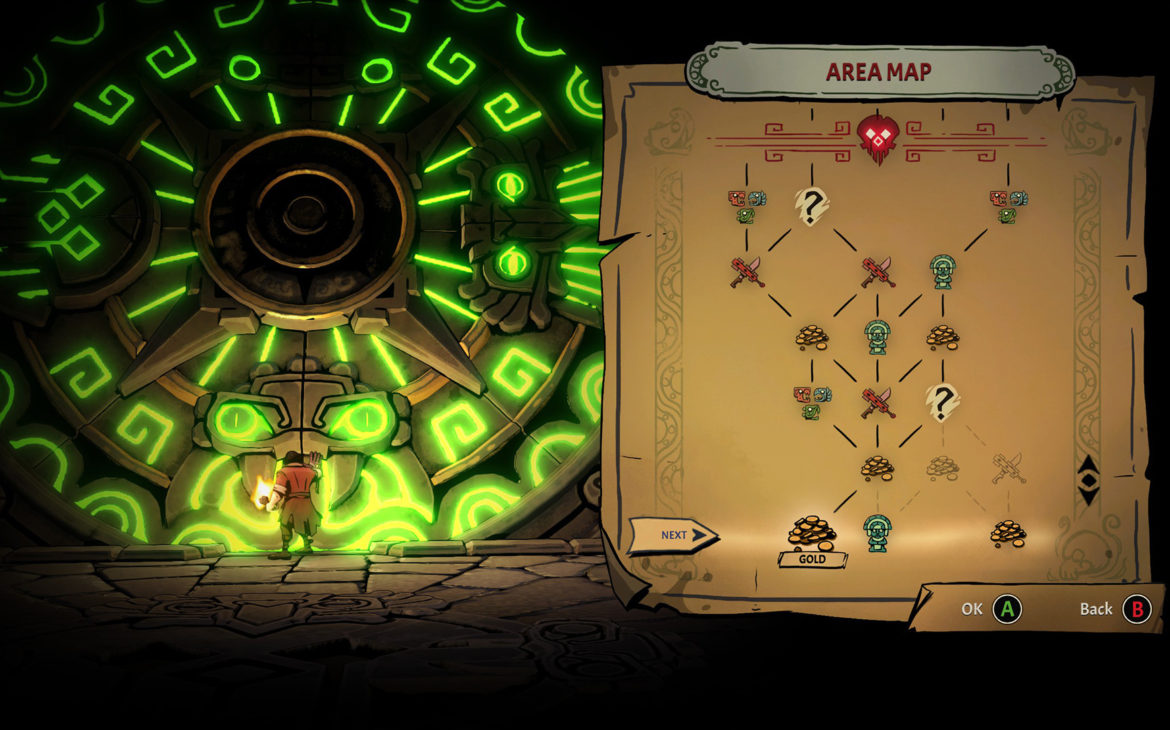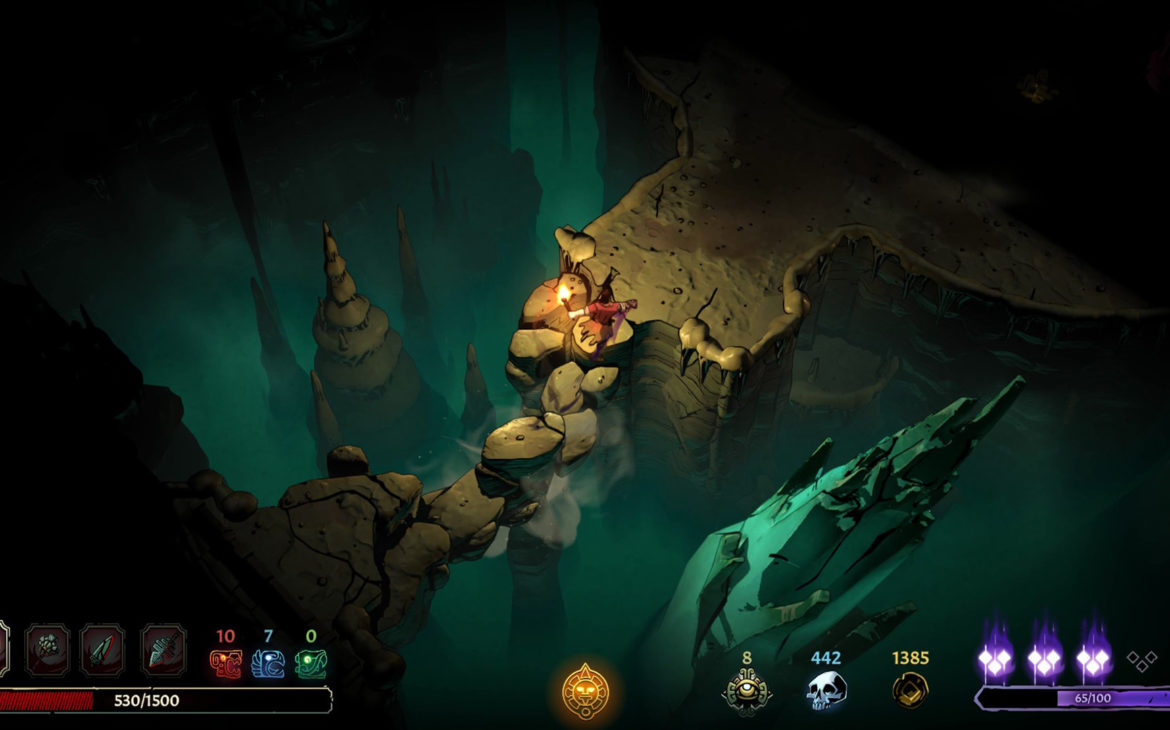Curse of the Dead Gods is another of these well-distilled roguelites that have come out in recent months, taking the best elements that players love about the genre, and honing them to a deadly sharp point. Spending time in early access, while a very similar game called Hades was garnering game-of-the-year plaudits, has meant that Curse of the Dead Gods has both suffered by comparison, and been enhanced by the experience of that other game.
Curse of the Dead Gods’ developers didn’t sit on their laurels, they boosted and enhanced and reworked multiple elements of their game until it was a valid competitor in the increasingly crowded roguelite market. Combining top-down isometric hack and slash gameplay with a parry and dodge system lifted from the soulslike genre, Curse of the Dead Gods is a honed and perfected amalgamation of two genres steeped in similar gameplay evolution.

So we should caveat right from the start that Curse of the Dead Gods doesn’t really feature any narrative. There are no cutscenes after levels or bosses, and there is little in the way of lore to ground you in its world. You play as a grizzled nameless warrior who comes across a cursed temple and then ventures deep into a series of ever-changing rooms inside. It feels somewhat like a mode from a larger game, like the Chalice dungeons in Bloodborne for example. Our nameless warrior isn’t out for revenge; he isn’t looking for a lost daughter, or trying to save the world. At best he’s a grave robber, but that’s just me projecting onto him, assuming he’s trying to make a dishonest buck and just happens to be doing the world a service in the process, ridding it of some troublesome Gods.
Nameless beardy warrior probably never should have entered the temple, because no sooner did he step inside than he’s locked in and falls afoul of the curse, a steadily building corruption that introduces debuffs and makes runs get harder as you get further. He’s also cursed to be revived after every death and forced to fight on again and again. In that way it provides a small in-universe explanation for the many deaths you will suffer.
The ever-changing procedurally-generated temple will be your home for the foreseeable, but it’s also home to a slew of Dead Gods with a pretty Aztec flavour. I say dead, but they must be undead, or just sleeping, because the moment you disturb them, they’re up and attacking you. In this roguelite, the temple is different every run. A run is made up of 7-8 stages or rooms. Each stage is crafted, but the order, variety and direction change every run.
The temple is split into different room types – New Weapon rooms (for if your starter options weren’t great), Weapon Upgrade rooms (essential as base damage is low, you can get one or two of these per run), Relic rooms (perks), Attribute rooms (Stats upgrades), gold rooms (Gold is essential if you don’t want to be incurring corruption all the time) and healing rooms (which heal you, at the cost of some corruption), and as you can see each comes with its benefits and pitfalls. There are also mystery rooms which could be any of the above.

As that list indicates, there are quite a lot of different systems in Curse of the Dead Gods. And that’s not even half of them. No matter what type of room (except healing) that you enter, you will face off against a number of enemies – slay enough and stay alive and you will reach a boss. Defeat the boss and you are awarded with loot; Crystal skulls, jade rings, and Blood Emblems.
Crystal skulls can be kept if you die, and are used to buy Blessings (Perks) and upgrade the altar where you start each run, eventually giving you access to better starting weapons and more choice. Jade Rings purchase these weapons so that they can appear randomly, and Blood Emblems are permanent unlocks for the developers to hide more blessings, weapons or altars behind – you only get one per boss, and only the first time you beat them.
Let’s talk about corruption, the curse of Curse of the Dead Gods. Every door you go through to reach a new room will curse you and increases your corruption. You can also be very easily corrupted by certain enemy types with purple-coloured magic attacks, so, you know, don’t get hit. Once your corruption reaches one hundred (that’s five doors or just one really bad fight) you are cursed with a debuff, ranging from benign like invisible dodging, to super-tough like every chest requires a parry to open, or corrupts you further, or masses of traps. You can keep being corrupted and cursed up to five times, all building on top of each other, earning yourself the dreaded final curse.
Some of the curses are actually kind of great. Bloodlust for example disables some healing effects you might have otherwise which are super rare, but then replaces gold drops from enemies with blood which heals you. This actually makes the game easier – because you can heal as you fight – if you fight well.
The temple can be pretty tough, and all these systems and curses working together can make getting to the boss pretty hard. Some conventions are just vindictive, like where the game will often follow a healing room with a massive and tricky fight with respawning enemies where you lose all your health. It’s also full of traps; statues fire arrows or fireballs at you or hit you with swords if you come too close, electric traps zap and stun you and spikes shoot up from the floor constantly. The temple wants to kill you, and succeeds more often than the enemies.
The first times through you only need to worry about one boss/champion. Then you’ll eventually progress past that and start needing to get to a second boss, and then third and so on, all in one go. After each boss thankfully one bar of corruption you’ve built up and at least one curse is lifted. Eventually, you need to beat 3-4 bosses in one run to actually complete the temple, but by that point you should be very well versed in the combat and actually able to dodge and parry out of most problems.

If all those systems weren’t enough, Curse of the Dead Gods has some quite solid combat, with a number of mechanics of its own. It falls pretty firmly into the soulslike combat model, all apart from actually getting souls from the dead. You must dodge and parry, and doing so either too late or too early will result in getting punished; you have five units of stamina to perform dodges and finishers, and staying out of combat for a moment will replenish them. There’s also the Soulslike aspect of having multiple weapon types, each with its own movesets. Some of these are solid melee types like swords and maces, while others like throwing axes require a completely different playstyle.
You also have secondary and tertiary weapons; secondary ones are often long range, such as guns and bows (both of which require gunblade style button presses for maximum damage) but also shields and poison claws; tertiary weapons are a combination, usually melee weapons with a long reach to them. The trouble with all these extra weapon systems is that most of them, including all long range and tertiary weapons, require stamina to use, which can leave you in a tight spot to get out of trouble after a combo with no stamina left.
At the beginning of each run you have a choice of random weaponry, but you must choose one of the options available, which can mean being stuck with runs where you have just terrible damage, or weapon types you don’t favour.
Combat is hard and requires a fair amount of practice but head into it in the same way as Hades for example recently, or Children or Morta, or Morbid, and you’ll fair okay. Dodging out of the way is essential and can often mean you can’t complete combos. Parrying is trickier and more high risk – there’s no Ghost of Tsushima-like block even if you missed the parry, you’re just exposed.
Combat also doesn’t get that much easier as you go. Though you earn lots of weapon types, you don’t get many that actually have much higher base damage, but at the same time enemies don’t really get harder the deeper into the temple you go. It a very level playing field most of the time, which can be frustrating when you’ve put hours and lots of crystal skulls into earning things. It’s a roguelite, but it treats difficulty like a roguelike.
There are also a few run-only stats I should mention; Constitution (Health), Dexterity (Agility + Damage) and Perception (item drop frequency and luck). You can build these up via enemy drops, relics and attribute rooms, if you have the gold, or wish to sacrifice some corruption to do so, but no stats and no weapons last beyond the run.

For a little isometric roguelite Curse of the Dead Gods is pretty good looking. The developers have created a fun and vibrant temple to explore, even if there’s no story behind it. There is a beautiful lighting system that is infused with the gameplay. You hold a torch most of the time as you explore, a torch that creates really compelling shadows and dark spaces, and really makes the temple feel like a very 3D space. In the light you are also stronger, and take less damage, but to fight you have to draw your sword, and put down your torch, plunging you into darkness. You constantly need to find things to burn and torches to light or else increase the risk and difficulty of the whole experience.
Though all these systems probably sound exhausting, Curse of the Dead Gods does a grand job of integrating all its ideas. Time in early access has allowed the developers to fine tune the balance in a lot of areas, making combat fun and fair, and giving the game a solid feel. However after my time with it, I do think there are areas where the balance is off.
There are very few ways to heal yourself. There are no healing items as far as I found, only the rooms that heal you at a cost in corruption. One or two curses allow you to heal by sacrificing gold drops from enemies, but when actually used the healing percentage is so incredibly low as to be almost ineffective. I get it’s a curse, so it shouldn’t be good, but I feel there was just one more system missing – even From Software games give you healing items. The lack of any tangible combat-based healing system here feels one step too far on the side of frustrating.
The second is the blessings and altars, the things you can buy with your crystal skulls. There are a ton of blessings, but not one gave me a way to heal in combat (see previous issue), and very few make much of a difference to gameplay. You can only equip three, and the amount of crystal skulls needed to unlock even one of the higher blessings or later altars requires a hundred or more. If you are beating bosses left and right, you don’t need the perks, but if you aren’t then the slog to get this many crystal skulls is crippling, and rarely rewards you with actual worthwhile upgrades.

While the timeframe of its release will have it compared unfavourably to Hades, Curse of the Dead Gods hits many of that game’s highs, and manages it’s own, slightly more traditional roguelite feel. It’s lack of any real plot may make it less appealing to some, but this also aligns it more with Dead Cells and the like, where the drive to continue lies more in honing your fighting skill than in wanting to further the story. And maybe in the end that’s a purer goal for a roguelite.
Combat is strong, challenging and full of diverse movesets and constantly changing gameplay. The soulslike elements gel wonderfully with the roguelite framework, because both genres at heart want the same thing from you – for dying to be a requisite to getting better.
Hopefully Curse of the Dead Gods can find its footing outside of Hades’ shadow, as a purer roguelite experience without all the trappings of narrative that Hades has. It seems to tick every other box for those who enjoyed that game last year and want another game cast from the same mold.
While its lack of any narrative and tangible reward is a shame, Curse of the Dead Gods is a strong and well-crafted roguelite experience with a meaty soulslike combat system, and a remarkable number of mechanics and systems all working seamlessly together.

Curse of the Dead Gods is available now on Nintendo Switch (review platform), PS4, Xbox One, and Steam.
Developer: Passtech Games
Publisher: Focus Home Interactive
Disclaimer: In order to complete this review, we were provided with a promotional copy of the game. For our full review policy, please go here.
If you enjoyed this article or any more of our content, please consider our Patreon.
Make sure to follow Finger Guns on our social channels –Twitter, Facebook, Twitch, Spotify or Apple Podcasts – to keep up to date on our news, reviews and features.
